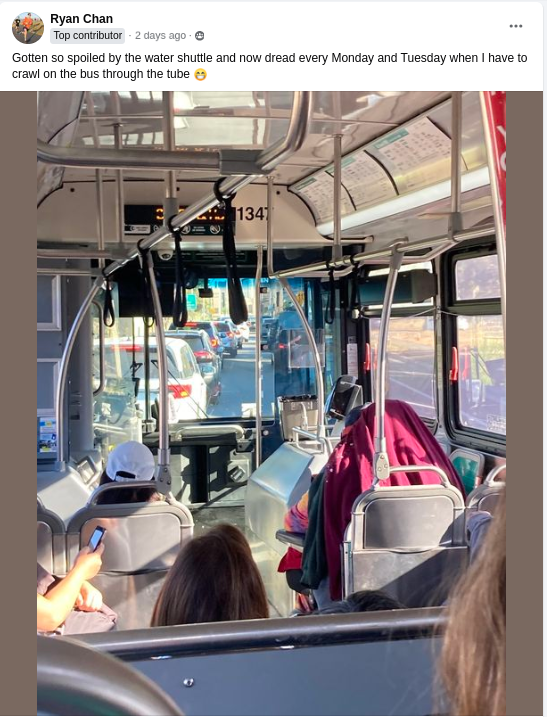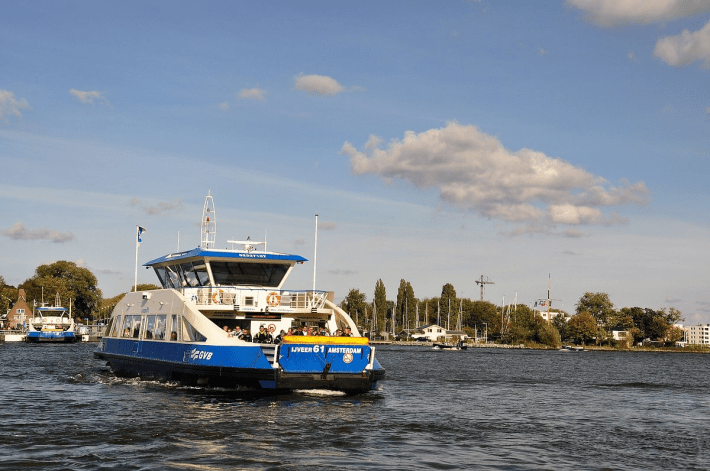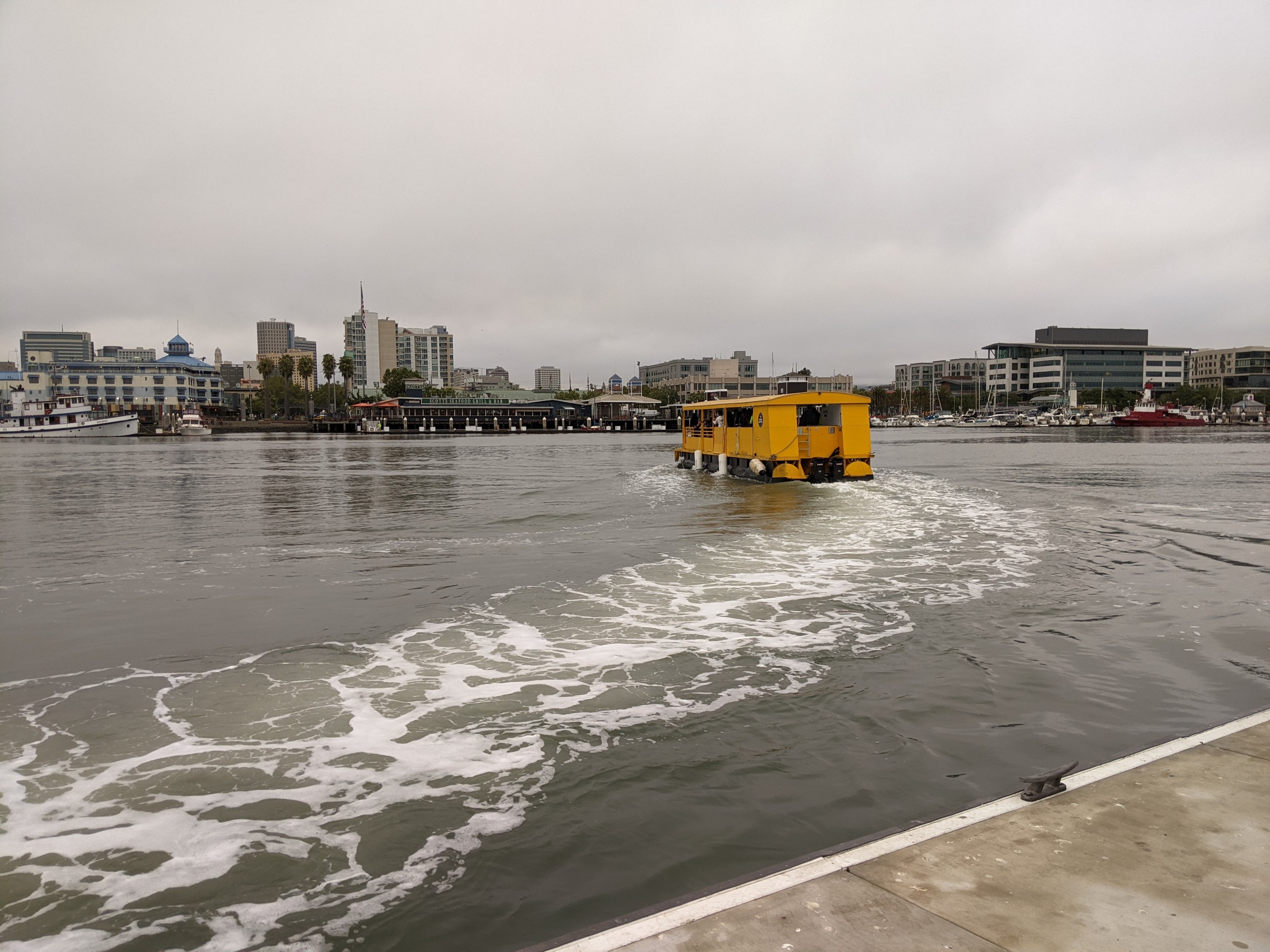Woodstock, the free water shuttle between Oakland's Jack London Square and Western Alameda, has been running for less than a month but is already an unqualified success. "In our first 29 days of service we had 17,534 total riders and 3,611 bicycles. We are analyzing the ridership and operational data now, which will be used to develop a revised schedule with increased frequency," wrote Sarah Henry, a spokesperson for the city of Alameda, which created the service.
"We hope to implement this new schedule later in the fall," added Henry. "And, given the early success of the service, we are already having discussions on how we might continue and expand the service beyond the two-year pilot."
One of the flaws with the current service is that there was only sufficient funding to run it five days a week. There are also huge gaps (the largest one is two hours and fifteen minutes) in the schedule, to give crews time for refueling and breaks.

In addition, the boat, while cute (see lead image), wasn't really designed for this use. Crews have gotten good at maneuvering the boat into its docks quickly, but the bottom line is that docking, loading, and unloading take longer than the actual trip, which is about three or four minutes.
As previously reported, the shuttle pilot was funded from various Bay Area transportation agencies to the tune of $2.7 million. The idea was to get a cheap but capable boat and a basic service going to "test the waters" and gauge demand for a more robust service. The hope is also to prove the need for a bike/ped bridge.
It's strange that demand for bike/ped infrastructure has to be proven, and yet expanding highways requires no such test. In fact, highways get widened despite mountains of evidence that it makes traffic worse.
That said, the water shuttle's 31-person capacity is often exceeded, leaving people on the dock. The need for a purpose-built, robust, traffic-proof regular water shuttle service is obvious.
And once again, the Netherlands has the answer on how to make cities safer and just better for people outside of cars. See photo below from Amsterdam:

Talks need to begin immediately about acquiring a bi-directional boat that "crashes" into the dock and drops a big ramp, as with the Buiksloterweg ferry shown in the image above from Amsterdam. A dedicated dock will have to be added, but the Woodstock pilot has shown exactly where to put them: add to and/or modify the public docks at the end of Broadway in Oakland and Bohol Circle Immigrant Park in Alameda. This lets the boat get as close as possible to BART in Oakland and the massive new housing developments in Alameda. It also makes the Alameda shopping center an easy trip from the retail-and-service-desert that is Jack London Square.
For the service in Amsterdam they actually run two boats, which leave every four minutes (that wait goes up to 12 minutes in the middle of night). Loading is a breeze: people just bike and walk on, sail across, and bike and walk off via huge ramps on the front and back. Below is a video of the thing in operation:
So where should the money come from to do it?
Somewhere out there is a politician with the leadership skills to put a stop to the so-called Oakland Alameda Access Project (OAAP). This is yet another destructive Caltrans plan to reconfigure and widen ramps, this time between the Posey Tube, I-880, and Oakland. Even the politicians who voted for it, when I've talked with them off the record, acknowledge that it's not going to accomplish a thing—not even for the drivers it's ostensibly intended to serve. The only people who will benefit from it are the consultants and construction workers getting their paychecks from a $152 million make-work project.
Can't we "make-work" on something beneficial to the community instead?
If the OAAP is allowed to move forward, it is going to require long periods (we're talking months and years) of partially and completely closing the Posey and Webster tubes. This is going to make for atrocious commutes via AC Transit and private automobiles. "Does seem like an argument for 24/7, five-day-a-week shuttle service. And we need a second boat," wrote Bike Walk Alameda's Cyndy Johnsen in a post on social media. The worst part is when the OAAP is finished, it will still have all the same choke points, just on the opposite side of I-880; it won't do a thing for drivers or bus riders.
Let's stop the project and instead use the money in a way that actually helps provide access between Oakland and Alameda. For $152 million, Oakland and Alameda could have its own Buiksloterweg ferry, facilitating tens of thousands more trips by foot, bicycle, BART, and Amtrak. It would amount to a rounding error on that budget to do a study on whether more capacity is justified for a bike/ped bridge. There'd also be more than enough money left over to light, improve, and open up the spaces under the Nimitz freeway to reduce the barrier effect so it's not so atrocious and dangerous for pedestrians and cyclists to get between Chinatown and Jack London Square.
The region's transportation problems are solvable. The cash and resources are ample. The problem, as usual, is a destructive inertia for pointless road reconfigurations and widenings and a lack of leaders strong enough to stop it. The real solution to improving Oakland-Alameda access is now there for anyone to ride. What will it take to get Bay Area's leaders to truly seize on it?





